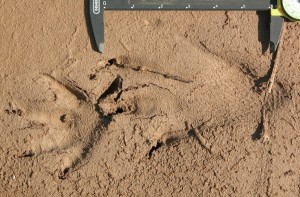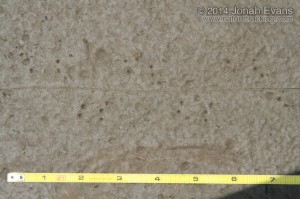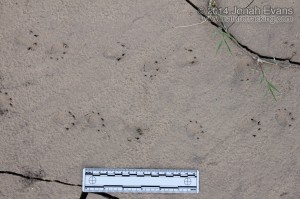“Herp” is a general term that refers to both reptiles and amphibians. Researchers that study these species are known as herpetologists. This group of animals includes: alligators, anurans (frogs and toads), lizards, salamanders, snakes, turtles, and more. The gallery below contains over 120 photos of reptile and amphibian tracks.
Herp Tracks Gallery Full Species List
- Alligator Tracks
- Baby Green Sea Turtle Tracks
- Box Turtle Burrow
- Box Turtle Tracks
- Bullfrog Tracks
- Caiman Tracks
- Frog Tracks
- Frog Scat
- Horned Lizard Scat
- Horned Lizard Tracks
- Lizard Claw Marks
- Lizard Overstep Trot
- Lizard Bipedal Running Tracks
- Lizard Scat
- Lizard Tracks
- Sidewinder Tracks
- Snake Scat
- Snake Tracks
- Snapping Turtle Tracks
- Tiger Salamander Tracks
- Toad Scat
- Toad Swimming Tracks
- Toad Tracks
- Tortoise Burrow
- Tortoise Scat
- Tortoise Tracks
- Turtle Eggs
- Turtle Tracks
- Western Diamondback Rattlesnake Bed
- Western Diamondback Rattlesnake Tracks
- Yellow Mud Turtle
Alligator tracks are very distinctive and rarely mistaken for anything other than beaver tracks. Unlike beavers, 5 toes show in front tracks and 4 show in the hinds. They also have a distinctively scaled appearance. Because crocodilians grow their entire lives, researchers have been able to correlate track size to body size. Hutton (1987) found that the body length (tip of nose to tip of tail) is about 14 times the length of the hind foot. Platt (2009) and found that the rear foot length (in mm) times 11.74 minus 7.4 gave the best results for crocodiles in Belize.
Anura is the order that includes frogs and toads. Frogs and toads both show 4 toes in front tracks and 5 in the hind tracks. When hopping, the front tracks often are found between the much larger hinds. The front feet tend to point inwards and form somewhat of a “K” shape. The 4 inner toes of the hind feet form a line sloping upward and outward. Toe 5 (the outermost toe) is short and points forwards (in lizards this toe points outwards).
Differentiating frog and toad tracks can be a challenge, but there are a few things to look for that can help. First, frogs usually hop and toads usually walk. However, I’ve seen numerous small desert toads hop constantly and I’ve watched a frog walk for a short distance. If you find a long walking trail of an anuran, it’s probably a toad. Second, toads tend to have relatively short and thick toes while frog toes tend to be long and thin.
Lizard tracks are often identified more easily from tail drags than footprints. Lizard tails leave relatively straight and thin lines that are quite distinctive from the tail drags of other species such as kangaroo rats. If you see a long tail drag with alternating blurry feet marks on each side, it’s likely a lizard.
Lizard tracks show 5 toes on the front and hind feet. The front feet are usually much smaller than the hinds and the toes are usually short and symmetrically arranged on the foot. On the hind feet, toe 4 (the ring finger) is the longest and toe 5 (the outermost toe) points distinctly outward.
Salamander tracks show 4 toes in the front tracks and 5 in the hinds. Toes are usually symmetrically arranged and are generally all about the same length. Front and hind feet are about the same size. Lizards have a noticeably long toe 4 (ring finger) on the hind feet, which are also much larger than their front feet.
Salamanders tend to use a slow understep walking pattern and any tail drag usually undulates from side to side. Meanwhile, lizard often trot, leaving far fewer tracks than a salamander, and lizard tail drags are generally straight.
Snake tracks usually looks like a sinuous shiny smudge on the ground. It is possible to tell the direction a snake is traveling for looking how the substrate is pushed away from the direction of travel in the curves of the trail. There is very little published on identifying snake tracks to the genus or species level.
Turtle tracks are very distinctive and easily identified. Because turtles almost always understep walk (hind foot landing behind the front), they take very short steps and leave an almost continuous line of tracks on each side fo the body. This creates an almost “tank tread” like appearance.
Turtles have large claws and 5 toes on front and hind feet, though usually 4 toes show in hind tracks.
The following images are the recent reptile and amphibian track observations from the North American Animal Tracks Database. This is an iNaturalist project where trackers share observations and help each other learn about animal tracks, all while contributing to scientific research.
Tracks and Sign of Reptiles and Amphibians is the only book dedicated to identifying reptile and amphibian tracks in North America. Filip Tkaczyk does a fantastic job explaining the little-explored world of herp tracks.
In this book you will find photos and life-size track drawings of turtle, frog, toad, lizard, salamander, snakes, and more. This book is the 4th in Stackpole’s ground-breaking series of tracking books that include Bird Tracks and Sign, Mammal Tracks and Sign, and Tracks and Sign of Insects and other Invertebrates.
Animal Tracks and Scat of California is a regional guide, but many of the species are found throughout North America. This guide includes mammals, birds, and even some reptiles, amphibians, and invertebrates. It is a great general tracking guide (full disclaimer: I am a co-author of this guide) and is a great bet if you want a single guide that covers more than just mammals. This book also has some helpful sections not found in Bird Tracks and Sign including a quick reference to life sized bird tracks.
Wildlife of the Pacific Northwest is a regional guide written by my friend and excellent tracker David Moskowitz. While the book primarily focuses on the Northwest, a lot of information applies nationwide. This tracking guide includes mammals, birds, reptiles, amphibians, and invertebrates. It dedicates an entire 32 pages specifically to birds. The guide also contains excellent original artwork by Dave and some incredible photography.














